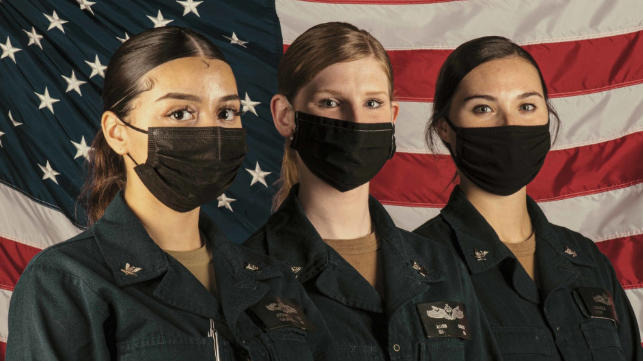This U.S. Navy Carrier's Top Helmsmen are Women

Out of a crew of 5,000 sailors aboard the supercarrier USS Theodore Roosevelt, only four are entrusted to steer in restricted maneuvering evolutions.
From the first days of the U.S. Navy, helmsmen have played an essential role, steering the country’s ships as they travel the seas. Typically drawn from the ship’s deck department, their objective is to drive the ship at sea during normal situations. However, during special evolutions and unique scenarios, the master helmsmen take charge.
“Any time the navigation team thinks it’s going to be a difficult sea state, we’ll come up,” said Sonar Technician (Surface) 1st Class Allison Coughlin, from Ronkonkoma, New York, one of the Theodore Roosevelt’s master helmsman. “When the ship is most likely to crash, that’s when we’re driving."
When a ship is executing a special sea-and-anchor detail, a strait transit, or pulling in or out of port, a master helmsman applies fine-tuned expertise and knowledge to navigate the changing waters, ensuring safety of the crew and operational efficiency of the ship, guaranteeing a steady course no matter the wind or tide.
Theodore Roosevelt’s helmsman qualification program makes it clear: any sailors, whether they have more than a decade of service under their belt or are fresh out of “A” school, will be given the same opportunity to prove themselves worthy of manning the helm.
“I didn’t know about the position at first,” said Coughlin. “I had never even been to the bridge before, but my chief said navigation was looking for more master helmsmen and asked me if I would be interested. I was unsure, but I wanted to get more command involvement under my belt too.”
Coughlin and her chain of command reached out to Theodore Roosevelt’s navigation department to begin the standard qualification process. She received hundreds of hours of hands-on training from other qualified sailors, spending days under instruction and behind the wheel until she qualified as a helmsman. Coughlin then routed a special request chit to start the master helmsman program.
Accepted into the program, she was present for every subsequent at-sea evolution, receiving valuable instruction on operating the helm during restricted maneuvering operations and similar events. With the support of her department, leadership, and fellow sailors, Coughlin became a fully-qualified master helmsman November 18, 2017.
Coughlin has served as a master helmsman for more than 120 special evolutions over three-and-a-half years, but still remembers her first watch. During the ship’s Composite Training Unit Exercise in 2017, she manned the helm for her first replenishment-at-sea as a qualified master helmsman.
“I was nervous when my instructor finally left me with the helm, because it felt like he was always there before,” said Coughlin. “I thought, ‘this is crazy,’ but then that pride kicks in and the training becomes second nature. After that, I was just so proud and really excited that the whole chain of command had so much trust in me. It’s like they were telling me, ‘you got this now, and it’s your turn to steer the ship while we’re 180 feet away from another ship.’”
Yeoman 3rd Class Alexandra Miller, from Annapolis, Maryland, another of Theodore Roosevelt’s master helmsman, shares that sense of accomplishment and pride with Coughlin.
“To me, it was one of those challenging qualifications that I wanted to get,” said Miller, who has piloted the ship for more than 25 special evolutions. “It’s cool to know that you are doing something really important. When I’m driving, when I’m keeping the ship on course, it makes it easier to launch and catch aircraft. What we do compliments the ship’s essential operations.”
“Personally, it means a lot to man the helm,” said Coughlin. “It shows that the chain of command has a lot of trust in you even as a lower enlisted sailor. They don’t look at rank or whether you’re a woman or a man; they don’t look at age — I mean, I got qualified at eighteen, and a couple of the other master helmsmen are currently eighteen and nineteen. When they see that you are capable, no matter who you are, and they trust you, that’s an awesome feeling.”
This article appears courtesy of U.S. Navy News and may be found in its original form here.
The opinions expressed herein are the author's and not necessarily those of The Maritime Executive.
